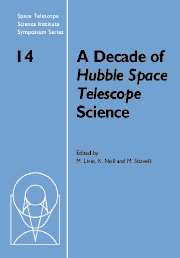Book contents
- Frontmatter
- Contents
- Participants
- Preface
- HST studies of Mars
- HST images of Jupiter's UV aurora
- Star formation
- SN1987A: The birth of a supernova remnant
- Globular clusters: The view from HST
- Ultraviolet absorption line studies of the Galactic interstellar medium with the Goddard High Resolution Spectrograph
- HST's view of the center of the Milky Way galaxy
- Stellar populations in dwarf galaxies: A review of the contribution of HST to our understanding of the nearby universe
- The formation of star clusters
- Starburst galaxies observed with the Hubble Space Telescope
- Supermassive black holes
- The HST Key Project to measure the Hubble Constant
- H0 from Type Ia supernovae
- Strong gravitational lensing: Cosmology from angles and redshifts
The HST Key Project to measure the Hubble Constant
Published online by Cambridge University Press: 13 August 2009
- Frontmatter
- Contents
- Participants
- Preface
- HST studies of Mars
- HST images of Jupiter's UV aurora
- Star formation
- SN1987A: The birth of a supernova remnant
- Globular clusters: The view from HST
- Ultraviolet absorption line studies of the Galactic interstellar medium with the Goddard High Resolution Spectrograph
- HST's view of the center of the Milky Way galaxy
- Stellar populations in dwarf galaxies: A review of the contribution of HST to our understanding of the nearby universe
- The formation of star clusters
- Starburst galaxies observed with the Hubble Space Telescope
- Supermassive black holes
- The HST Key Project to measure the Hubble Constant
- H0 from Type Ia supernovae
- Strong gravitational lensing: Cosmology from angles and redshifts
Summary
A decade of observing with HST also coincides with the completion of the last of the initial three Key Projects for HST, the measurement of the Hubble constant, H0. Here we present the final results of the Hubble Space Telescope (HST) Key Project to measure the Hubble constant, summarizing our method, the results and the uncertainties. The Key Project results are based on a Cepheid calibration of several secondary distance methods applied over the range of about 60 to 400 Mpc. Based on the Key Project Cepheid calibration and its application to five secondary methods (type Ia supernovae, the Tully-Fisher relation, surface brightness fluctuations, type II supernovae, and the fundamental plane for elliptical galaxies), a combined value of H0 = 72 ± 8 km/sec/Mpc is obtained. An age conflict is avoided for current estimates of globular clusters and H0 if we live in A-dominated (or other form of dark energy) universe.
Introduction
When planning HST, pinning down H0 was one of the scientific programs that drove the design and construction of the telescope. Although the original plans for a Large Space Telescope were scaled down during the mid-1970s, one of the primary arguments for an aperture of at least 2.4m was to enable the detection of Cepheid variables in the Virgo cluster (Smith 1989), a goal that was achieved within months of the corrective optics being installed in HST in December, 1993.
- Type
- Chapter
- Information
- A Decade of Hubble Space Telescope Science , pp. 214 - 221Publisher: Cambridge University PressPrint publication year: 2003
- 1
- Cited by

